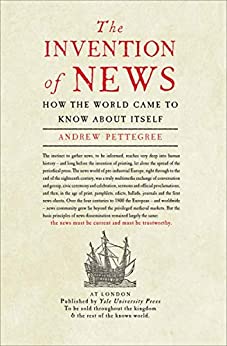The Invention of News
These days I’m spending a lot of time thinking about the news: how it is shaped, who controls the story, how we receive it.* These questions are not only an important part of the political dialogue today, but an important part of the book I’m working on. In search of a dimly remembered idea, I recently pulled a book off my shelf that is at least in part about the growth of newspapers. I didn’t find what I was looking for, but I was sucked into a fascinating account of how the news as we know it came to be.

At a time when digital media is transforming the way news is delivered–and by whom– Andrew Pettegree offers a reminder that newspapers too were once a revolutionary form of delivering information. In The Invention of News: How The World Came To Know About Itself, Pettegree looks at the changing definition, use, control, and distribution of the news from the medieval world to the age of revolution.
Building on his previous work in the ground-breaking The Book in the Renaissance,** Pettegree demonstrates how access to news became increasingly widespread, moving from private information networks run by medieval elites, through sixteenth century news pamphlets and news singers, to the newspapers of the eighteenth century. He looks at the development of postal systems, private couriers and the printing press. He considers the importance of the introduction of paper, the rise of coffee shops and the growth of a literate middle class. He discusses the roles played by news pamphlets in the Reformation and by newspapers in the American and French Revolutions.
Some of the most interesting sections of The Invention of News deal not with the development of new media, but the creation of new audiences. Technology often outpaced demand. Early printers, finding the traditional market for large books would not keep them solvent, created new markets for more ephemeral products. The leap from broadsheets to newspapers presented a similar challenge: the first newspapers were bewildering to audiences accustomed to news pamphlets that told a single story from beginning to end. Perhaps, at some level, the medium is the message.
*I must admit that I am more plugged in than I was in the past thanks to Twitter. Embarrassing, but true.
**Also well worth reading. Printing and the Protestant Reformation are more closely linked than you might think.
A version of this review appeared in Shelf Awareness for Readers a million years ago.





https://www.amazon.com/gp/customer-reviews/RSFNZ6QTSLP28/ref=cm_cr_dp_d_rvw_ttl?ie=UTF8&ASIN=B00SI02FKC
Pamela, I haven’t read the book you wrote about today, but on of his previous books, “Brand Luther” was superb. I linked to my Amazon review of it.
Ooh! I’ll have to add that one to my list.